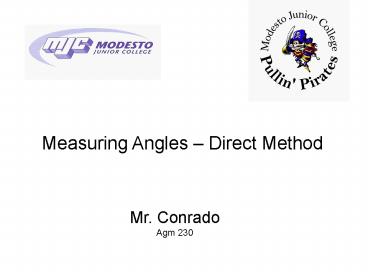Measuring Angles Direct Method PowerPoint PPT Presentation
1 / 21
Title: Measuring Angles Direct Method
1
Measuring Angles Direct Method
Mr. Conrado Agm 230
2
Angles
- An angle defines the rate at which two lines or
planes diverge from a common point.
3
Angles
- All angles have three parts
- Backsight The baseline or point used as zero
angle. - Vertex Point where the two lines meet.
- Foresight The second line or point
4
DD DMS
- Two systems are used for recording angels
- Decimal Degrees (DD) Fractions of a degree are
expressed as a decimal. - Degrees-Minutes-Seconds Partial degrees are
expressed as minutes () and partial minutes are
expressed as seconds ()
5
DMS
- One degree equals 60 minutes
- One minute equals 60 seconds
6
Adding Subtracting DMS
- Is more difficult in DMS method.
- Ie. Add 20 - 45 25 to
- 30 - 24 33
- 69 and 62 are not possible and therefore must
be reduced - Step 1 subtract 60 from the seconds until
remainder is less than 60. Add the number of
whole 60s to the minutes. - Step 2 is subtracted from the minutes until the
remainder is less than 60. Add the number of
whole 60s to the degrees. - The result is the correct angle
- 20 45 27
- 30 24 35
- step 1 50 69 62
- 60
- step 2 50 70 02
- 60
- 51 10 02
7
Direct Method of Measuring Angles
- Requires an instrument
- To measure vertical angles the scope must be able
to rotate up and down - Transits
- Theodolites
- Total Stations
- Precision is a major difference
- Levels usually limited to one degree
- Total Station and Theodolites capable of less
than 20 minutes
8
Angle Measurement Steps
- Center the instrument
- Zero set the angle scale
- Align the scope on the backsight
- Turn the angle
- Record the angle
9
Centering the Instrument
- For complete accuracy the instrument must be
centered over the vertex of the angle. - This is done by suspending a plumb bob from the
center of the instrument usually over a surveyors
nail or stake. - If done incorrectly the potential for error is
great.
10
Centering the Instrument
- Procedure
- Most instruments allow for slight adjustments
after mounting by loosening the instrument from
the tri-pod or the leveling screws. - To set the tripod use the plumb bob through the
mount center as a guide. - Mount and level instrument leaving base slightly
loose for later adjustment.
11
Centering the Instrument
- When centered the base is tightened and
instrument re-leveled. - Re-check plumb bob for center
- If wind in present use a wind block to lesson
wind effect.
12
Zero Setting the Instrument
- After the instrument is centered the angle scale
can be moved to zero or any other starting angle. - Loosen the scale lock
- Align scope on backsight
- Rotate scale until desired angle is set
- Snug scale lock
13
Aligning the Instrument of the Backsight
- When shooting longer distances very small scope
movement may result in large swings of the
crosshairs. - Use the tangent screw to make fine adjustments to
increase ease and accuracy.
14
Turning the Angle
- Now rotate the scope until the crosshairs are
aligned with the second scope.
15
Record the Angle
- All instruments measure angles but different
makes use different scales. - Most manual instruments use a vernier scale.
16
Reading Angles David White Instrument
- The 360 horizontal circle is divided into
quadrants 0-90 - The circle is marked by degrees and numbered
every 10 degrees - The horizontal circle is referred to as the
degree scale - The instrument vernier divides each degree on the
circle into 12 equal parts of 5 minutes each. (60
minutes per degree)
17
Reading Angles David White Instrument
- The vernier is marked in minutes starting at 60
in the center and reading both left and right to
30. The 60 mark is both 60 and zero. - Up on the vernier scale is the same direction as
up on the degree scale.
18
Reading Angles David White Instrument
- Example
- Note point at which 60 on the vernier touches
degree scale. If 60 coincides exactly with a
degree mark there are no fractions of a degree. - If 60 on vernier does not coincide exactly with
degree mark, your degree reading is the line
which 60 has just passed plus a fraction of the
next degree.
19
Reading Angles David White Instrument
- Example continued
- Start at 60 on the vernier and read up until you
find a minute line that coincides exactly with a
degree line. - Each line on the vernier represents 5 (5, 10,
15, 20, 25, 30) - Example 71 20
20
Reading Angles David White Instrument
- Example continued
- If no minute mark up coincides read the vernier
scale back. - When reading back from 30 to 60 the 60 mark is
now 60 not zero. Therefore your reading will be
30, 35, 40, etc. - Example 71 45
21
Assignments
- LAB
- How to measure horizontal angles with a level.
- HOMEWORK
- Read chapter 7 Landscaper Surveying

